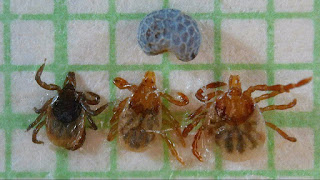 |
| Photo provided by David Schmipf |
Nymphal Ixodes scapularis ticks are still very small, about 1-1.5mm, although this is a little larger than a larva. They tend to look like a very small adult female, having a very dark brown or black scutum that covers half to 2/3rds of their back and a pale tan or red brown posterior end. To the right we have a photo of three nymphs on a 1mm grid and shown above the ticks is a poppy seed for size reference. On the left we have an I. scapularis nymph, in the middle is a Dermacentor variabilis (also known as the dog or wood tick) nymph and on the right is an Amblyomma americanum (also known as the lone star tick) nymph.
Ixodes nymphs are a little easier to see than larvae, as they have somewhat darker coloration, but the posterior end of their bodies can still be semi-transparent. And, as you can surmise from their still tiny size, would hide easily under hair or in areas where you can't see or reach without assistance. This makes them very problematic, because during its larval blood-meal, a tick can pick up pathogens and is able to spread those pathogens on to its next prey. The Minnesota Department of Health estimates as many as one in five Ixodes nymphs may be carrying Borrelia burgdorferi, the bacteria responsible for causing Lyme disease. Because Ixodes nymphs are now potentially capable of spreading disease when they feed, they tend to be less picky about their prey and, if they bite a human, they can be easily overlooked and allowed to feed long enough to increase the risk of pathogen transmission like B. burgdorferi, some sources consider nymphal ticks to be the riskiest stage for bites.
Ixodes nymph season is typically reported as being mid-May through June and then tapering off in July. However, peak nymph season may vary depending on weather patterns and geographic location. Finding nymphs in our active tick collection process is a challenge, because they are so small, and because they tend not to be out questing for food as long in the warm seasons as their adult counterparts. However, when we find more than adults in a given area year after year, we can conclude that the species has taken hold in that location instead of being accidentally carried in on people or animals as they migrate through on their travels. When a tick species takes a hold and is seen to be actively reproducing and increasing its population in a new area, this helps us get a picture of how populations change, expand and migrate over time. Also, this information is crucial to understanding the risk of disease emergence in new regions.
Currently, in northern Minnesota we do not find A. americanum ticks, although there are reports of some being spotted in the southern areas of Minnesota. While A. americanum and D. variabilis ticks can spread other pathogenic microorganisms to humans and domestic animals, neither are believed to be able to cause Lyme disease by the transmission of B. burgdorferi.
No matter where you enjoy the great outdoors, the adoption of appropriate protection methods to avoid tick bites and conducting thorough tick checks daily are the best line of defense against the spread of tick-borne diseases.
-C. Fisher

No comments:
Post a Comment